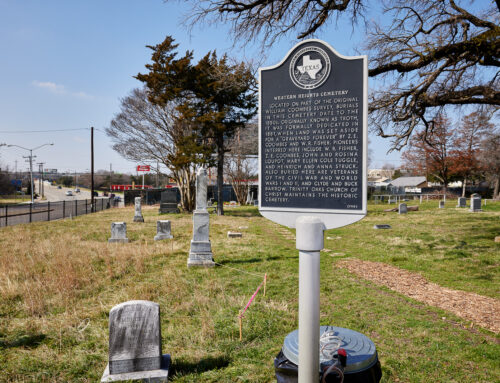The Builder: Stephanie Bohan
Stephanie Bohan moved to Oak Cliff the day schools and businesses shut down because of the coronavirus in March 2020.
But her contributions to Dallas over the past 17 years make this Nashville native an honorary Texan.
Bohan, who lives in Beckley Club Estates with her husband, Michael, was named CEO of Dallas-based adoption nonprofit Hope Cottage in May.
She’s also pursuing a master’s degree in theology at the Southern Methodist University Perkins School of Theology.
Bohan spent eight days in El Salvador this past semester with Professor Harold J. Recinos and a cohort of SMU seminarians.
She met leaders of Pro-Búsqueda, a nonprofit association for families of children who disappeared during the civil war in El Salvador in the 1980s. And she says she witnessed “layers of suffering in the world.”
“I hadn’t seen anything like that in my life,” she says. “You see military on the streets protecting anything of value. Razor wire on every fence on every building. The most intense poverty I’ve ever seen. No national system for clean water.”
Now they are planning service projects for their return to El Salvador.
“If you show me suffering, I’m going to fiercely step into a space and do something to help,” she says. “I don’t know how to do much, but I can’t see suffering and not want to do something.”
The Dallas Holocaust and Human Rights Museum brought Bohan to Dallas in 2005. She also had a job offer at the same time from the Dallas Children’s Theater, which was congruent with her job in Nashville.
But when she explained both opportunities to her niece, who was 9 at the time, the girl told her to choose the Holocaust museum, “because something like that should never happen again.”
“It just set the tone for my entire time with the museum,” Bohan says. “That started a path of choosing organizations that really mattered to me.”
Agape Clinic was her next stop.
The Old East Dallas-based free clinic was only open four half-days a week when Bohan started as executive director.
By the time she left, the clinic was open seven days a week, including some evening clinics, and served 18,000 patient visits per year.
She also oversaw “a great expansion of services to include specialty medical care, dental services and a host of women’s health offerings.”
No matter how many donors she could find or how much she increased funding, she realized there is a never-ending well of need for free health care. Her husband is a registered nurse at UT Southwestern, and his enthusiasm for the profession also made her realize that health care is not her passion. After 10 years, she wanted to try something different.
Bohan spent about a year working for Bonton Farms, which is planning to build a wellness center.
When the position at Hope Cottage came up, it spoke to her heart, she says.
“I was unable to have children, so I filled my family full of animals and a sweet loving husband and great friendships and service to others in my community,” she says. “I have a deep empathy for people who come to us to create families. It was something I knew I could be passionate about.”
Bohan, 50, says she and her husband love their new neighborhood, where they live with an epileptic dog and a three-legged cat. And she’s pleased to be leading a 100-year-old nonprofit in continuing its mission and looking for ways to grow its services.
“When you live a life of service, you receive far more blessings than you give. I’ve received so many blessings that I know I never deserved just because I choose to live my life this way,” she says. “Everything I do is so tiny compared to what I receive.”
The Artist: Jacks Haupt
Jacks Haupt performed in talent shows at Winnetka Elementary as a child, singing songs from Mexican pop group RBD.
Next month, she performs in New York City’s Central Park as part of a tour supporting the Disney documentary Mija.
Haupt, 22, stars in the documentary about Los Angeles-based music manager Doris Muñoz, “whose undocumented family relies on her ability to break pop stars.”
Muñoz scouted Haupt from Instagram in 2019. Haupt had already recorded her song “3 AM,” written when she was 17 years old.
At the time she was influenced by Mexican American singer Cuco.
“He would write songs that tell a story, and I wanted to make songs that tell a story,” she told the website Mitú recently.
This year, the song got a whole new life with a vampire-themed music video directed in Los Angeles by Ambar Navarro and filmed on 16-mm.
Otherwise, her career has been very DIY. She conceives and creates her own music videos, and her two EPs were recorded on an iPhone 6s at a time when Haupt was living out of her car.
The singer describes herself as “Chicana,” and that identity is a prominent aspect of her artistry. She’s influenced by classic R&B and chopped-and-screwed Texas rap music. But she also admires Amy Winehouse, which is evident in some of her style and phrasing, as well as Radiohead front man Thom Yorke.
“Thom Yorke is so intellectual and so specific about his art,” she says. “It’s completely artistic. That’s what I admire about him. He’s unique.”
Haupt, who started writing songs at 14, learned to play electric guitar by watching YouTube, initially because she wanted to impress a boy in high school. Her grandfather, who played in bands in his teens and 20s, taught her some chords and how to tune the guitar. She also plays keyboards.
The child of two immigrants, her parents haven’t always been supportive of her musical dreams because they wanted her to go to college and be a lawyer.
“They’re just trying to protect me,” she says.
But there’s no other choice for Haupt.
“This film is to show that you can do whatever you want,” she says. “As long as you’re passionate about something, and you’re chasing your dreams and looking forward for something, I think that’s what should matter.”
The Leader: Leah Longoria Huggins
Leah Longoria Huggins knew nothing about ballet folklorico when she became the dance and drill team instructor at Sunset High School 12 years ago.
“Anyone in that art form will tell you, it takes decades,” to learn, she says. “Because the information is so vast. Just to give you a little rundown: There are 32 states in Mexico. Each state has a different costume, a different instrument, a different kind of music, and in different regions of that state there might be different costumes, different instruments.”
She wanted to provide ballet folklorico experience for Sunset students who couldn’t afford private lessons, so she enrolled herself in a year of one-on-one instruction in the art form.
Even though local school districts have ballet folklorico programs, Longoria Huggins noticed there were no competitions specifically for them. So she and her colleagues recently developed one, the North Texas Ballet Folklorico Competition. Next they are working to get the art form recognized as a UIL activity.
Many students come into the Sunset dance program with no previous experience. They’re total beginners, Longoria Huggins says.
Even so, many have gone on to dance in collegiate programs, or they’ve become dance instructors themselves.
One of her favorite success stories is that of Lizette Rivera, who became a Trinity Valley Community College Cardette and is now on the dance team at Texas Woman’s University.
Rivera wasn’t enrolled in dance class at Sunset, and she’d never really taken lessons. She just auditioned for the drill team in her sophomore year, and Longoria Huggins could see her potential. Now Rivera is dancing collegiately based only on her three years of training at Sunset High School.
“We can say it’s because of our instruction, but it’s because of her drive,” Longoria Huggins says. “I mean, she just had no fear, and she worked very hard. I’ve never seen a student work as hard as she did.”
Some teachers may have summers off, but not Longoria Huggins. Dance camps begin the week after school ends. There was drill-team officer camp and then the DISD summer dance intensive through the end of June. Then dance company camp begins July 15.
Sunset High School is known for its highly competitive marching band, and the dance program is part of that. So Longoria Huggins is there on nights and weekends for band practices and competitions, which are year-round.
Besides that, she’s constantly fundraising to give Sunset dance students travel and competition opportunities. It may take six months to raise enough money to bring a troupe to competition in Austin, she says. But it’s worth it to give her students the experience.
“About 30% of it is actually teaching dance,” she says.
The rest is lesson planning, organizing and ordering costumes, raising money, designing T-shirts, turning in piles of paperwork for field trips, communicating with parents and managing a budget.
“People think it’s a teacher at the board teaching,” she says. “That’s the easy part. There are a lot of things we have to do that have nothing to do with teaching.”
The relationships she has with current and former students, and seeing them take dance into college or their careers, makes it worthwhile for her and assistant dance director Amanda Longoria Perales, who is not related to Longoria Huggins.
Even those who don’t take dance any further than high school can blossom into confidence through the program, she says.
Longoria Huggins, 35, is married to husband, Rylie, and they live in Preston Hollow with their kids, 4-year-old Lily and 16-month-old C.J. When it’s time to give financially at the end of the year, they always donate to the Sunset dance program, because they both believe in its power to change people’s lives.
“I have taught in other studios, and Dallas ISD has the best kids,” she says. “Put that in writing. The best kids. That’s why I’ve been with DISD for 12 years and I’ve never gone to another school district.”
The Fighter: Katherine Homan
Suing the City of Dallas for violating its own rules had to be done, if you’re Katherine Homan.
“I didn’t have a job they could threaten,” she says. “There was nothing that I was going to be sacrificing by putting my name on that lawsuit, and to me, this was about making the city acknowledge that it did something wrong and that it was overreaching its power.”
She was gob-smacked during what a newspaper columnist called “the most bizarre” City Council meeting in February 2019. A last-minute shakeup allowed Council to hold a simple-majority vote, winning out against neighbors’ wishes in a zoning case related to a planned fitness center at Methodist Dallas Medical Center, which would’ve eliminated an old pecan grove.
City Council “took an illegal vote” on the matter, Homan says, and two courts have agreed.
Homan sued the City for violating its own rules and won a summary judgment in October 2019. The City appealed, and Homan won again March 31. Attorneys for Dallas didn’t appeal before the clock ran out on the case in May, meaning the City is under judgment to pay Homan’s attorney fees.
But it also puts the city on notice that citizens of Dallas won’t stand for its flouting the rules, she says.
“When something like this happens, you can’t just tuck your tail between your legs and say, ‘They have the power; I don’t.’” she says. “We’re supposed to be watchdogs, not lapdogs.”
This isn’t her first rodeo as a citizen activist.
The Long Island, New York, native moved to Dallas with her husband, Dr. Richard Homan, in the 1970s. Dr. Homan taught at UT Southwestern Medical Center and treated patients at the VA Hospital. He died of a brain tumor in 2003, when he was chair of the department of neurology at Texas Tech University Health Sciences Center.
“Can you imagine? He was a neurologist, and he died of a brain tumor,” she says.
She was in her 60s when her husband died, and she decided she had to “get a life.”
The Advocate first featured Homan in 2009, in a story about her house. Built in 2001, it was the first “green home” in Dallas, and she spent years preaching the gospel of green building practices.
That threw her into the realm of urban planning, and she “started to realize how much this representative government of ours involves citizen participation.”
A retired history teacher, she joined the League of Women Voters, became its president within three years and was on its board for 16 years.
The Fort Worth Avenue Development Group, a neighborhood nonprofit founded in 2001, caught her attention around 2006 with a plan to rezone the West Commerce/Fort Worth Avenue area to attract businesses to the corridor.
“It was flophouses and prostitutes and drug dealers,” back then, she says.
“They had an amazing game plan to become the stewards of Fort Worth Avenue, and I learned about what a well-designed new development was so we would have a walkable urban corridor that was lined with trees and landscaped and a vibrant mix of retail with restaurants and commercial. What you see now is 15 years’ worth of that work.”
Her experience working with that group, “was transformative” she says.
They raised $25,000 for bike lanes, when the City of Dallas had none, and brought public art to the corridor. More important, they stopped a plan to tear out the intersection of Beckley and Commerce, including an old-growth pecan tree.
A new design for that intersection, which preserved the tree, was created by City of Dallas planner Don Raines, an Oak Cliff resident, and built in 2018.
Besides that, Homan is always one to stand up for environmental causes, such as the effort to ban fracking in Dallas city parks in 2013.
And she likes to get involved with big urban planning ideas — she and Oak Cliff resident Paul Carden were the first to raise the idea for the Interstate 35 deck park, for example.
Even though she’d taken the City to court, Homan was recognized recently during a women’s history month lunch at City Hall, where she was given the Outstanding Public Service Award.
“If we hadn’t sued, then the rezoning would have gone through and been on the books. The pecan-tree grove would’ve been built over,” she says. “By suing the City and saying, ‘That was an illegal vote that you took,’ it started a halt on the project, which the city had given them the OK for.”






